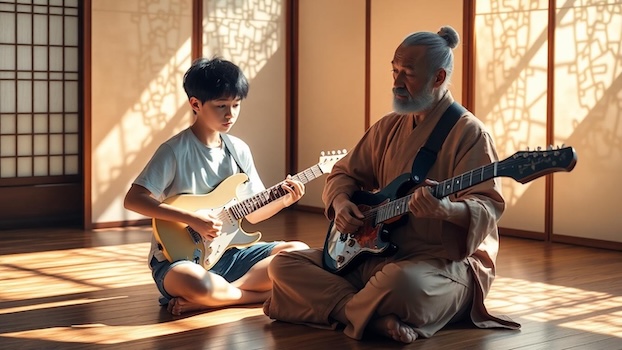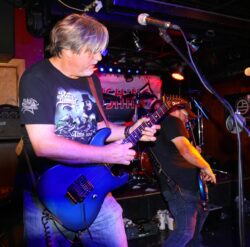
Finding YOUR unique sound as a guitarist can feel like searching for a needle in a haystack. But in the crowded music scene, it’s what sets you apart. Every time you pick up the guitar, there’s an opportunity to express something that’s unmistakably YOU.
Developing a unique style is a creative desire deep down in all musicians; it’s a necessary step to stand out and capture the audience’s attention.
With so many guitarists playing similar riffs and chords, your distinct sound becomes your signature. Ask yourself what you like best about your favorite guitarists.
Let’s explore harnessing your individuality and how to develop your unique sound and stand out as a guitarist. Make it resonate through every note you play.
Of course, the first thing you want to do, is to choose the perfect beginner guitar for your needs. If you already have your guitar, strap up and get those fingers moving! Time to dig down deep and usher in your personality with your playing.
Nailing down your personal style as a guitarist isn’t all about settling on a set routine of techniques. It’s more about channeling who you are, at your core, into your music—making your guitar feel like an extension of your soul.
Music is an art form. When you share a piece of yourself, from wayyy down deep within the core of who you are, that’s where the magic is.
I feel that most people can tell when someone is being genuine or fake. It’s like watching a movie with bad actors, it’s just not very believable. There’s a shallowness when you’re not being yourself and others will notice. It won’t be interesting and they will tune you out.
Your style should reflect your personality, interests, and the unique story you want to tell through your music. Think of it as your signature or your voice in the world of guitar sounds.
Let’s dig into how to paint that picture on your canvas of strings by exploring your individual influences and experimenting with genres.
Think about the guitarists who made you want to pick up this instrument in the first place. For me, it was Randy Rhoads, after being blown away listening to the album Diary of a Madman. It spoke to me.
The sounds and styles are more than just something to admire; they’re building blocks to constructing your own musical identity.
By examining these influences, you can dissect what specifically resonates with you. Is it Jimi Hendrix’s groundbreaking use of distortion and feedback or maybe Slash’s greasy blues-inspired pentatonic phrasing?
Write down a list of your guitar heroes and pinpoint aspects of their style that speak to you.
This exploration can inform and fuel your creativity, offering insights into your path towards developing your unique sound. You might also want to check out other resources like Rock Guitar Lessons For Beginners, which often spotlight influential players and their methods.
Sticking to what you know might be tempting, but straying a bit from the beaten path leads to discoveries that can be transformative.
Dipping your toes into different genres allows you to draw batting trills from jazz or syncopated rhythms from funk that you can thread into your own compositions. Each genre offers a palette of new techniques and sounds that can broaden your musical horizon.
Here’s why stepping into diverse genres can be beneficial:
Think of it as enhancing your musical toolbox, adding versatility and diversity to your skillset adds depth to your creative output.
For those interested in the nuances of various playing styles, examining some Guitar Picking Styles can be a great start. Remember, standing out isn’t just about playing differently—it’s about resonating authentically with the music you create.

Creating your own style as a guitarist blends both creativity and technique. It goes beyond just hitting the right notes. It’s about making each note resonate with a true sense of emotion and honesty.
This section dives into mastering techniques that can heighten your individuality, unlocking new realms of sonic potential.
Alternate tunings can feel like opening a portal to unexplored worlds of sound. Trying out tunings beyond the standard can instantly infuse new life into your guitar playing.
Each tuning creates a distinct chord, a divergent soundscape that evokes a fresh emotional response. Whether it’s the open-hearted resonance of Open G (DGDGBD) or the airy, lush landscape of (DADGAD), these tunings can ignite creative ideas that otherwise might remain hidden.
By shifting the pitch of your strings, your fingers will naturally find new paths over the fretboard, guiding you toward melodies and chord progressions you wouldn’t stumble upon in standard tuning.
For beginners curious about these possibilities but perhaps hesitant, a great resource to explore is How To Tune A Guitar For Beginners. Alternate tunings are a springboard for innovation.
So, next time you’re seeking inspiration, re-tune your guitar and see where it takes you. Your unique sound is just a twist of the tuning peg away.
Every guitarist has their bag of tricks, and adding distinct techniques can separate your sound from the crowd. Techniques such as fingerpicking, tapping, and pinch harmonics, are all specialized methods that bring personality and flair to a performance.
Similar to how a painter employs different brushes and strokes, these techniques are tools that a guitarist can leverage to color their musical expression in ways words never could.
Fingerpicking allows the guitarist to engage individual strings with accuracy and feeling, making space for even the simplest chord to stir emotion uniquely. Check out some superb fingerpicking from the great Merle Travis.
On the other hand, tapping brings forth a modern element, often resulting in fast-paced runs or distinct rhythmic patterns that make solos truly stand out. Take a look at Eddie describing how he started tapping—Eddie Van Halen
And don’t forget about pinch harmonics—a technique that involves your thumb becoming an extension of the pick rather than a means for holding it. Your thumb becomes one with your pick attack, which means your thumb will literally graze the string the nanosecond after your pick, causing that famous distinct high-pitch squeal.
You wanna hear some amazing pinch harmonics? Well, there’s no one better to show you than Dimebag Darrell.
Experimenting with these approaches can drastically alter the way your music is perceived and felt.
For more interesting info on tips and techniques, check out these posts:
Remember, these methods are about adding intricacy to your style, turning each performance into a personal masterpiece.
These tools don’t just make sounds—they make statements. Consider how each technique you master adds another layer to your unique sound, making each performance your signature.

In the pursuit to develop your unique sound as a guitarist, the choices you make in sound design and equipment can make all the difference.
Picking the right gear is all about showcasing who you are and speaking with confidence. When I pick a guitar, the specific pickups, and the effects I use, it all plays an integral role in crafting not just the sound, but the story I want to tell.
Let’s break down the key aspects of this sonic identity.
When it comes to choosing a guitar that speaks to your style, don’t just look at the brand or the price tag. It’s all about the connection you feel when it sits in your hands.
Think of the guitar as your musical partner. Just as a photographer has their go-to lens, every guitarist needs an instrument that complements their voice. Your pickup selection is like adjusting the aperture, bringing those raw tones into focus.
Whether you lean towards the warmth of a vintage hollow body or the punch of a solid body electric, each guitar character carries a different vibe. Hear the same strings sing differently depending on their context.
Consider these aspects when matching pickups to your playing style:
Remember, the right combo can transform your guitar into an effortless extension of your personal style.
Effects pedals are like spices in a chef’s kitchen—essential for crafting a dish that’s distinctly yours. While some might see them as just additions, the truth is they can fundamentally alter and define your sound.
Delays, overdrives, choruses—each pedal colors your music in a different shade, molding an otherwise plain canvas into a masterpiece.
Consider how these pedals can refine your tone:
One of the keys is to experiment with combinations to both elevate and complement your natural tones.
Use your pedals to layer textures and dimensions. This dynamic plays an important part in how you develop your unique sound signature.
In the maze of pedals and potential, remember that each effect is a brushstroke in your own narrative. Use them thoughtfully to enhance, not overshadow, your melodies.
Bringing your guitar ideas to life means picking the right amplifier. Whether you’re cranking out power chords or exploring mellower tones, the amp you choose makes a difference.
Each has its own voice, shaping the music you create. So, what’s the sound in your head?
Treading the waters of originality in music, especially as a guitarist, can be akin to walking a tightrope. It’s about balancing between honoring your inspirations and carving out your unique riff.
With the constant hum of familiar notes in the background, the true challenge lies not just in being different, but in being authentically you.
This often means shifting your focus inward, reflecting on your own life and experiences, rather than solely looking for external uniqueness.

Imagine originality as a mirror—the clearer your reflection, the more distinct your musical identity.
This journey inward is less about chasing new experiences and more about discovering and accepting who you truly are.
Real originality springs from understanding what moves and defines you as an individual.
Your musical fingerprint emerges when you dig deep and translate raw feelings into sound. From these internal explorations, those genuine pieces of music shine, making even familiar chords feel fresh and profoundly personal.
I believe that the very essence of your playing comes from within. All the emotions you feel, you know, if you’re sad or happy, if you’re angry, if you feel lost, or you’re in love, whatever you’re going through, that will come through in your playing.
The many types of self-expression, like the way you bend a note, the way you slide into a riff, the way you attack a chord or a note that could be hard or light, all that makes a difference in carrying that emotion into your playing.
So these forms of expression aren’t just technical aspects of your playing, they can be eye-opening moments that resonate with your audience.
I speak from experience when I tell you that listening to a particular song, riff, or solo; changed my life. The music touched me so deeply that not only did I get goosebumps after hearing it, but it completely transformed my whole world.
Be yourself and you will always be original —Steve, String Shock
Engage in self-reflection with targeted questions that tap into your emotional and musical core. This method enriches personal style and ensures your sound resonates on a deeper level.
True originality doesn’t require rewriting the musical rulebook. It’s the interplay of your unique thought patterns, experiences, and styles.
Consider each of us like a mosaic, contributing different pieces to the bigger picture. This uniqueness isn’t about being different in every note. It’s about being sincere and letting your genuine self play through.
While some may believe raw emotion alone can convey uniqueness, without musical depth, even pure emotion can fail to pierce through the surface.
By expanding your musical knowledge, you sharpen your toolkit to craft and identify sounds that resonate.
By bridging this knowledge with self-discovery, you land on an artistic sweet spot, broadening your ability to convey messages with both heart and head. Your authentic voice gains more clarity with each note.
Every note you play adds your own voice to the music world. Embracing individuality can be challenging but incredibly rewarding. While techniques sharpen your skill, remember, your unique sound is your story.
Explore guitar techniques. Dive into new genres and experiences. Keep your curiosity alive and courage unfaltering. If you’re searching for more ways to refine your sound, learning about basic rock guitar techniques can be a great starting point.
Your journey as a guitarist is personal and ever-evolving. Cherish it. Invite your audience into your musical narrative, and leave a lasting impression through the authenticity that only you can offer.
Your sound already exists within you—now, SET IT FREE!

Lorem ipsum dolor sit amet, consectetur adipiscing elit. Praesent sit amet elementum massa. Ut gravida risus at dui dapibus tristique...Read More
Mr. Cool says:
Fantastic advice! I love how you emphasize the importance of developing a personal and unique guitar sound. Experimenting with different techniques, gear, and genres is such a great way to find your own voice. It’s also refreshing to hear about the value of patience and persistence in the process. Developing a sound that’s truly your own takes time, but your tips really encourage staying creative and open to new possibilities. Thanks for sharing such valuable insights for guitarists looking to carve out their musical identity!
Steve says:
Makes me happy to hear that you enjoyed reading this post. Thanks so much.
Genie says:
Although I don’t know how to play the guitar, I find the idea of developing a unique sound really inspiring. It’s fascinating how blending personal experiences, exploring different genres, and experimenting with techniques can shape such a distinct style. If I ever learn to play, I’d definitely focus on expressing my own emotions and individuality through music.
Steve says:
Thank you Genie! In my opinion, developing your own voice is so important in creating music that’s unique and one of a kind.
Herman says:
This blog beautifully captures the essence of discovering your unique voice as a guitarist. It’s inspiring to see the emphasis on blending technique, self-expression, and exploration to create a truly personal sound. The actionable tips, like experimenting with genres, alternate tunings, and reflecting on influences, offer a clear path for musicians at any level. The focus on authenticity—playing from the heart—is a great reminder that music is as much about emotion as it is about skill. A must-read for anyone looking to make their guitar playing truly unforgettable!
Steve says:
Yes, being an original is easy when you just be yourself. There’s no other YOU! 😎
Eric says:
Hey Steve!
I just read your incredible piece about finding your unique sound, and that quote of yours really hit home: “Be yourself and you will always be original.” It got me thinking about something deeper, how did you personally discover your authentic voice on the guitar? Was there a specific moment or experience that made you realize you were no longer just copying your heroes, but actually creating something uniquely “Steve”?
I particularly resonated with your point about emotions flowing through playing styles. You mentioned how different emotional states affect everything from note bending to chord attacks. I’d love to hear about a song or piece you’ve written that came from a really powerful emotional place. What was the story behind it?
Your section on gear choices as storytelling tools was fascinating too. Since you seem to view equipment as an extension of personal expression, I’m curious, what’s the one piece of gear in your setup that you feel most represents your musical identity, and why?
Looking forward to diving deeper into this conversation!
All the Best,
Eric
Steve says:
Thank you Eric.
On the first question, I noticed my personality coming out when I would cover up a mistake while playing. By doing this, I developed my own methods of bending a string or developing with my vibrato. Mistakes lead to innovations I always say.
2nd question: Going through many changes in life as we all go through, angry emotions made me hit the strings harder, like almost trying to break them…lol Feeling sad made me fingerpick open ‘airy’ chords that ring out. Whatever emotion I’d be going through at the moment would manifest into my playing. I’ve written some angry aggressive songs but also beautiful other-worldly melodies. That’s the magic of being a musician.
3rd question: Out of all the effects I’ve used over the years, I’d say the ‘wah wah pedal’ is my fave! Ever since I heard Jimi Hendrix, this pedal has been my best friend. It just has that human-like voice that makes your emotions scream out of your soul.